My last blog showed the image captured as first light for Big Bertha’s new TS 2.5” Rack and Pinion Focuser, replacing the Orion Crayford focuser she came with and told what I thought then was “the rest of the story” of the focuser, the SGPro autofocus routine, and my continuing struggles to get the hardware and software to work together. Following that night in mid-August (you may recall after working on the step-size exercise for three hours, I gave up on the EAF and captured the data on NGC6888 Crescent Nebula without autofocusing during the sequence), I became even more determined to not be defeated by the little red box that is the ZWO EAF!
This blog is NOW the “rest of the story” of experiments (conducted during the day, inside) to measure my telescopes’ focuser’s movement distance to the EAF’s in/out movement commands and exercises (conducted at night, outside under clear skies) to determine the appropriate step size for the SGPro’s EAF algorithm. Although I don’t have a full data set, and thus the definitive answer across all my telescope and filter combinations – I am very comfortable now with running the procedures, have mostly succeeded in using the EAF throughout the imaging sequence and can declare – I have NOT been defeated by the little red box!!
So, as with my previous blog, I feel as if you deserve fair warning – this blog is mostly about the equipment and my autofocuser learning campaign, although I have included the images throughout the story. If you’re interested in the autofocuser trials and tribulations, please read on. If, on the other hand, you’re all about just seeing the images and are not so interested in the collection process (and my fumbling through it…) then head on over to the galleries and take a look at:
M31 Andromeda Galaxy at: https://beersastrophotography.com/gallery/m31-andromeda-galaxy/
NGC281 Pacman Nebula at: https://beersastrophotography.com/gallery/ngc281-pacman-nebula/
NGC7635 Bubble Nebula at: https://beersastrophotography.com/gallery/ngc7635-bubble-nebula/
IC5146 Cocoon Nebula at: https://beersastrophotography.com/gallery/ic5146-cocoon-nebula/
…and a pretty cool image of Sadr (my primary focus star throughout these exercises) taken with a tri-Bahtinov mask at: https://beersastrophotography.com/gallery/sadr-gamma-cygni-%ce%b3-cyg-star/
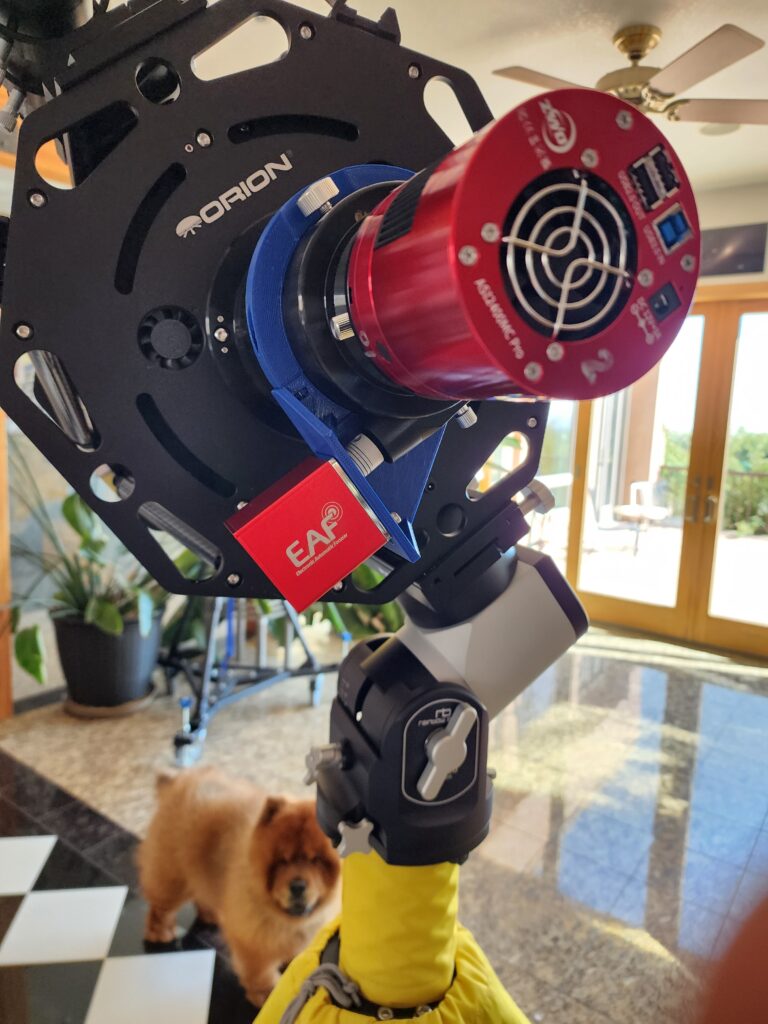
I have not been defeated by that little red box!!!
As you may recall from my last blog, since I purchased the ZWO EAF autofocuser in November 2023, I’ve been struggling with the SGPro EAF algorithm when I use autofocus during a sequence. Most times it would fail – repeatedly attempting the focus routine at the designated time (I had it set for once an hour), never coming to a greater than 90% confidence solution, and ultimately returning the focuser to its starting point – taking up imaging time without changing the focus. So, while I had some “free time” during our dark skies trip to Powderhorn over the 4th of July weekend, I decided to read the SGPro instructions (YES, really!). There I found an exercise to determine the algorithm’s appropriate step size for your equipment. While I was at Powderhorn, I had decided I didn’t want to waste valuable dark skies time on it (especially since the instructions start off by saying “you’ll need approximately 20 minutes and a lot of patience”). So, I continued to turn off the autofocus routine during that trip and deferred the exercise until I had a clear night at home.
My first clear skies opportunity at home was 28 July 2024. I attempted the step-size exercise – it failed miserably! The focuser started at it’s in focus point – and continued to step-by-step move more and more out of focus (instead of moving half of the total number of steps out of focus, then moving back into and through focus – forming a V). In the course of troubleshooting the issue with SGPro support, I remembered a conversation I’d had with MikeinWI, who I’d met through Thingiverse while searching for a 3D digital print for the autofocuser’s bracket. At that time, he’d said he had changed from his telescope’s Crayford (friction-based, https://en.wikipedia.org/wiki/Crayford_focuser ) focuser to a rack-and-pinion focuser. I reached out to him with my current issue and asked about the rack and pinion focuser. He sent me the link to the Teleskop Systems focuser he purchased and said he was very happy with it. I passed that link on to Paul, telling him I had one more experiment to do, but after that I was considering buying one for Big Bertha.
That in/out focuser experiment, suggested by SGPro Tech Support to ensure the focuser is moving the same distance in and out against gravity given the same EAF movement command, can be done at any time including inside, during the day. I conducted the experiment with the Crayford focuser during the weekend of 4 August. It revealed that the Crayford focuser (with the tension screws properly tightened) was being moved nearly the same distance in and out. But I discovered, I had the “reverse direction” check mark selected in the SGPro autofocus settings – so the algorithm (more specifically, my selected settings) were to blame, not the focuser.
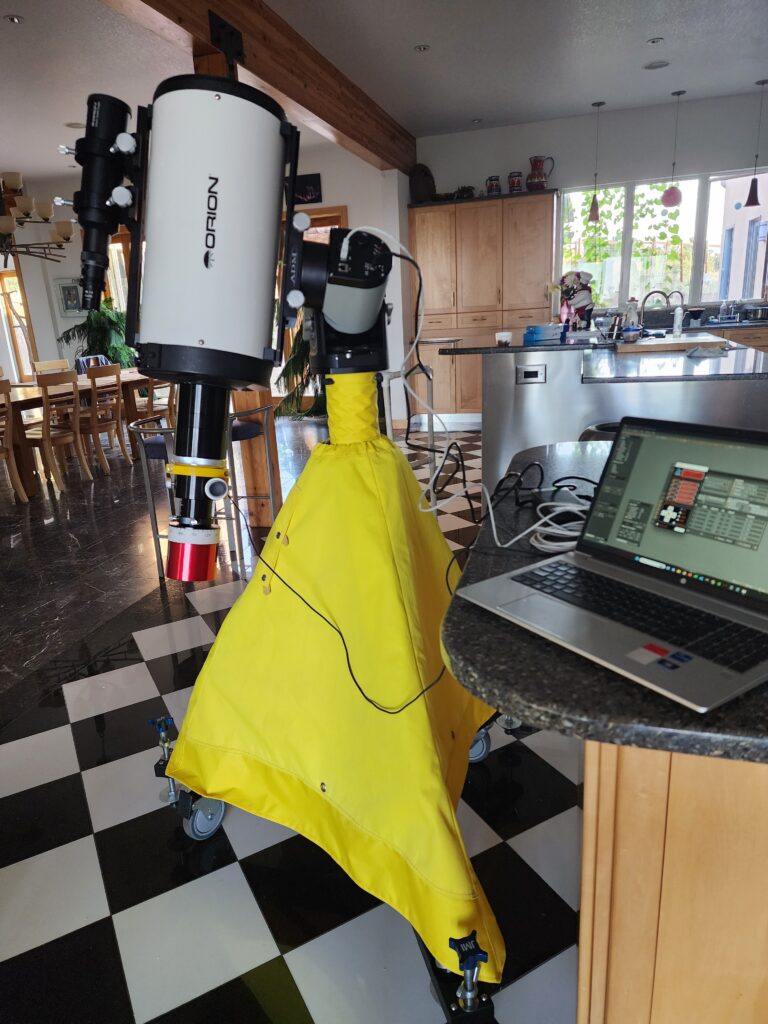
While I was in the midst of the experiment (before the discovery that it was my SGP settings not the focuser at fault) Paul ordered the new rack and pinion focuser! Miraculously enough, It arrived a few days later from England. So I had a new toy (er, I mean piece of equipment) to integrate into my set-up!
The night of 16 August was our first clear night since the 28 July step-size exercise, the Crayford focuser in/out movement experiment, and the receipt of the TS 2.5” Rack and Pinion focuser. I started the step size experiment, with the new R&P focuser installer on Big Bertha, at dark (approximately 2100MDT) and worked on it (patiently?) until almost midnight! I was very thankful that I had decided NOT to attempt this in dark skies! The result was better than late July (with the reverse direction checkmark selected), but still not good enough for the autofocuser to run reliably. So, again, I turned off the autofocus routine and turned my attention to using the rest of the night to capture some data on NGC6888 Crescent Nebula.
While I was “sleeping” and Big Bertha was capturing the Crescent Nebula data, it occurred to me that the two tension screws on the R&P focuser might not have been tightened enough to produce the same in/out movement despite the rack and pinion mechanism. So, pictured below is the in/out experiment conducted on 20 August with the R&P focuser’s thumb screws both tightened relatively tight (i.e., tight enough to provide sufficient pressure, but not tight enough to lock the mechanism). That seemed to be the correct formula for getting the same step size command to move the focuser the same distance in and out. Small steps…in the right direction!

Clear nights, let the exercise and learning campaign begin…
Another two weeks of cloudy nights and rainy weather passed until the week before and through the Labor Day weekend (which was the September 2024 New Moon), when we had a streak of clear skies. So, I set out to use those clear nights to run the SGP EAF step-size exercise across a sampling of my telescopes and filters.
Tuesday, 27 August 2024 was the first of those clear nights. I decided to start with Big Bertha and the LeXtreme filter imaging the NGC281 Pacman Nebula, which I hadn’t imaged since my early days of imaging (September 2021).
I got started at about 2030, once astronomical twilight was in full swing, getting the telescope polar aligned, the cabling and power all connected. I first ran the EAF on the focus star sequence (Sadr) with a step size of 150 – and it performed very well. I could have just gone with that lucky guess, but decided to run the step-size exercise to get the real, correct answer. The result was 150 steps per move, with 9 moves.
So, I set that step-size into SGPro’s BB-G158 equipment profile and began the sequence. The EAF’s algorithm worked well in NGC281’s area of the sky, resolving the focus point, and giving me the confidence to run the sequence throughout the night with the EAF refocusing every 60 minutes. I started the sequence by 21:15 – just about an hour from set-up through gaining successful EAF step-size knowledge, to capture!
The image of NGC281 Pacman Nebula will be dubbed “first successful light” with the ZWO EAF!! Its gallery post is: https://beersastrophotography.com/gallery/ngc281-pacman-nebula/
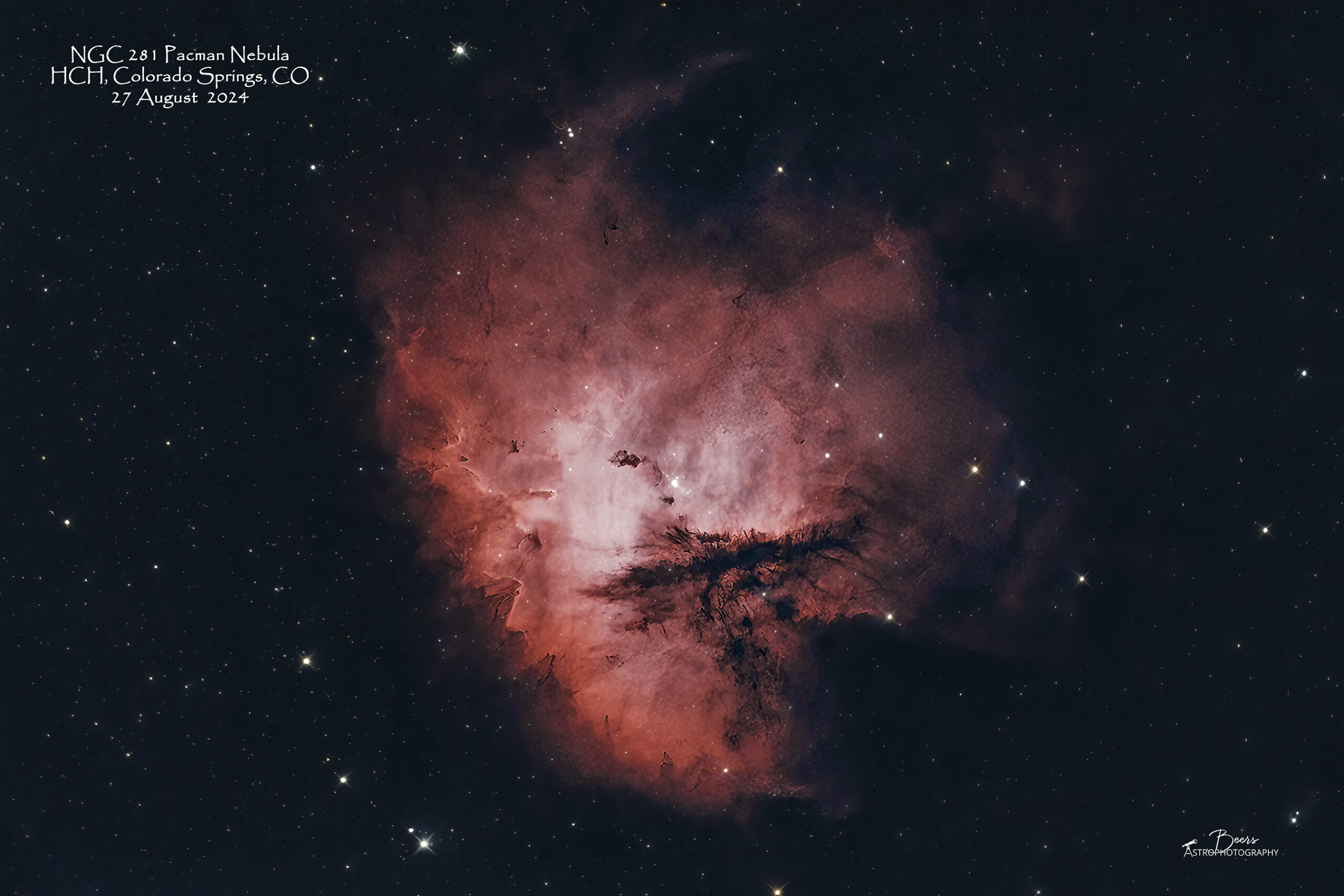
Our next clear night was 30 August 2024. That night, motivated by having reprocessed 2022-gathered M31 data earlier in the week for a print for neighbor-Sandy as a thank-you for her help in the great Zeus escape last month, I decided to reimage M31 to gather fresh data. That’s a large enough target to warrant using the Southern Cross (600mm focal length) and the lack of moon that night warranted using the LPro light pollution filter.
I started the night with the SC-LPro EAF step size test. When I ran the step size exercise, I did the math to calculate the step-size wrong, dividing by steps-1, rather than (steps-1)/2 coming up with a step size of 87.5 – 100 depending upon which end of the 3-5 times out of focus I used. I decided to go with step size = 100, since smaller step sizes had proven problematic in the past. I ran autofocus routine with step size = 100, it resolved at a HFR=1.9 so I went with that value for the SC-LPro configuration. BTW – the next day when I entered all the data into a spreadsheet and did the math correctly, I came up with a step size of 175.
The image of M31 Andromeda is shown below, for all the target fun facts and (other collection) details, take a look at the gallery at: https://beersastrophotography.com/gallery/m31-andromeda-galaxy/
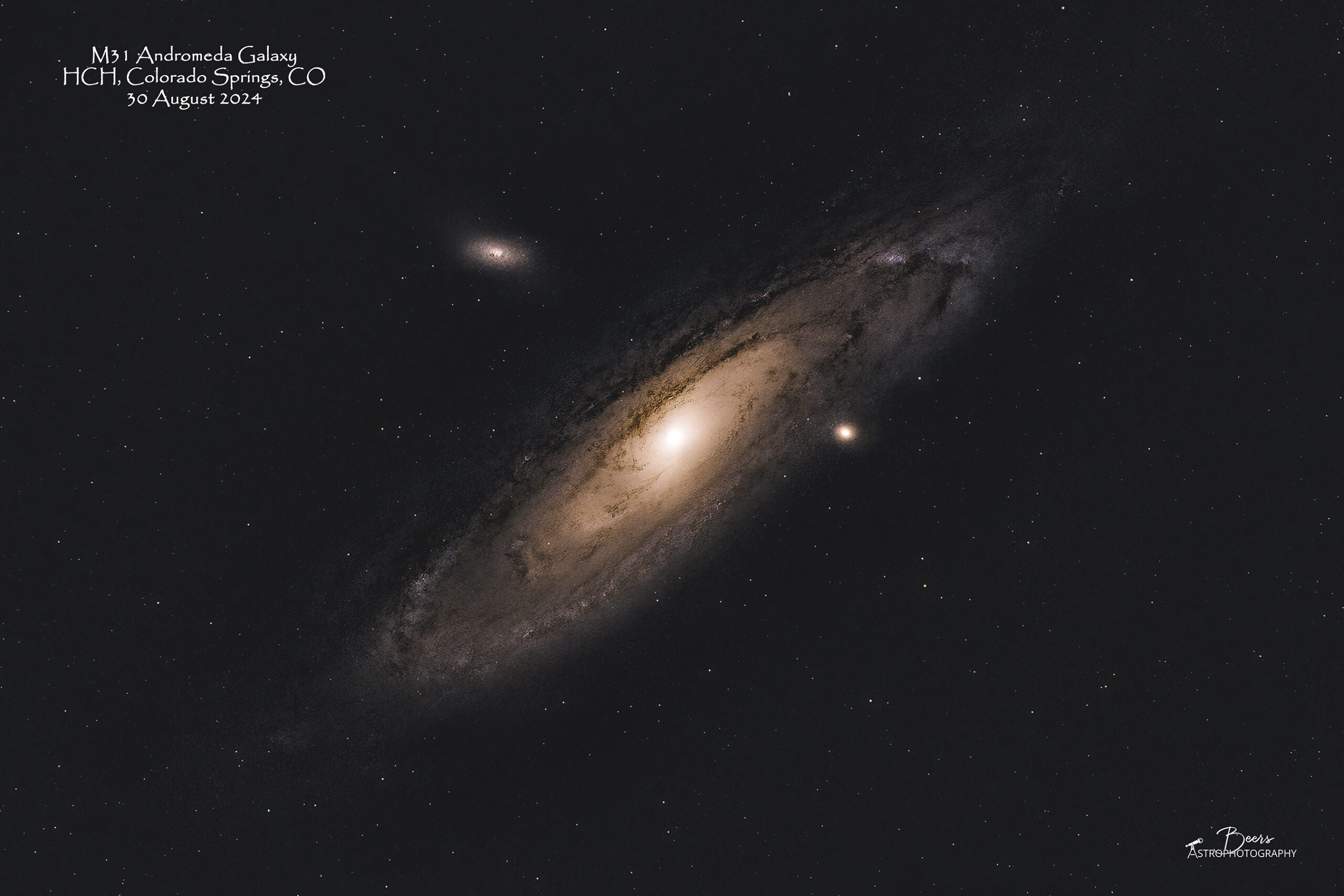
On 31 August 2024, I decided that I should give Big Zeus an opportunity to “play” in this experiment/exercise. I haven’t imaged with Big Zeus since 5 May 2023, before I got the Rainbow Astro RST-300 mount and the ZWO EAF in November 2023. Even though, when I was doing the digital printing of the EAF bracket for Big Bertha (8” RC) from MikeinWI and reached out to him for a design for Big Zeus (10” RC) – which he designed and printed, I’d never assembled Big Zeus to test him out on the new mount or with the new autofocuser (and it’s custom-made bracket). I figured it was about time to give him a try. So, I took Big Bertha off the RST-300 and replaced her with Big Zeus, attaching the EAF with its bracket. After assembling everything, I ran the in/out experiment to verify Big Zeus’ Crayford focuser was behaving properly to in/out commands from the ZWO EAF. The screws were tightened appropriately, so everything worked like a charm. Then I updated profiles in SGP and built the plan to image the Bubble Nebula and waited for nightfall.

I started the evening with the SGP autofocus step size test. I came up with the step size of 175 – concluding that (the next day when I had a chance to “analyze” the data in a little less sleep deprived state) the step size goes with the filter, not the telescope focal length. The autofocus test went well.
But…it’s always something (especially when you use equipment you haven’t used in awhile)! When I went to start the sequence – something was making a call to the EQ-6R mount’s (the old mount that the Rainbow Astro RST-300 had replaced) EQASCOM driver. It didn’t dawn on me what was going on even while I was watching the PHD2 calibration – moving through an inordinate number of steps in the north-south then east-west direction with no apparent movement of the mount. I shut down all the equipment, scratched my head, restarted it again – and again, the EQASCOM driver came up (in addition to the iHubo ASCOM driver that was controlling the RST-300). At that point, the light came on! I had changed the SGP profile, but I had not changed the PHD2 equipment profile from the EQ-6R mount to the RST-300. When I did that and restarted all the SW – miraculously, only the RST-300’s ASCOM driver came up and the PHD2 calibration succeeded.
The image of the Bubble Nebula captured on 31 August 2024 (shown below and in the gallery at: https://beersastrophotography.com/gallery/ngc7635-bubble-nebula/ represented “first light” with Big Zeus on the Rainbow Astro RST-300 and with the ZWO EAF auto focuser – with a successful night of imaging throughout the evening!
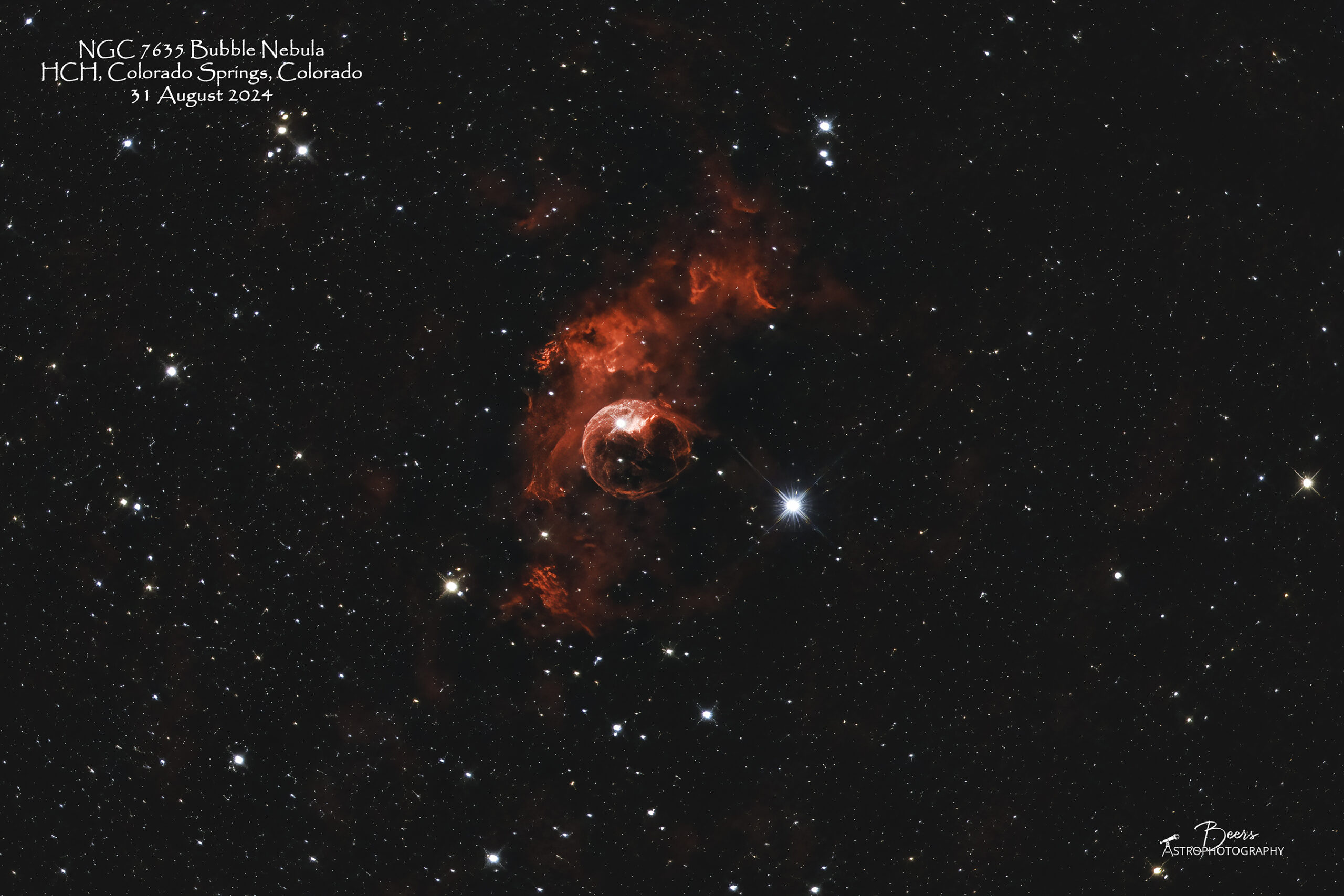
The next night, 1 September 2024, was also clear. I decided to image (my nemesis) the SH2-129 Flying Bat Nebula with the Southern Cross and the OIII filter, to see if I could get more data on the OU-4 Giant Squid (blue) portion of the image. The ZWO EAF – SGP autofocusing exercise to determine step size worked well on the Sadr focus star, giving me a step size of 75. But then, when I moved to the target area, the focusing routine would not resolve. I don’t know if it is because there were not very many stars visible in that area (with the OIII filter?) but when the focuser moved to the 4-step out-of-focus point, there were not enough stars (only about 5 stars) to form a good HFR average. I ran the exercise a couple of times and continued to get a step size of 75, then played with numbers around that point, but never got the routine to resolve. So again, I turned off the EAF and imaged for the rest of the night without the autofocus routine interrupting the capture of the OIII data while I had a moonless night. (I haven’t processed that image yet, so no photo-evidence of that night exists, yet!)
We had our final clear night with very little moon on 6 September 2024. I used the night to again verify the EAF performance with Big Zeus. My original plan was to image the SH2-101 Tulip Nebula from dark until it set at about 03:00MDT, then image M52 the Cassiopeia Salt and Pepper Cluster. As I was creating the those SGP sequences, I remembered I wanted to image IC5146 Cocoon Nebula with Big Zeus – so I switched to that target to image throughout the entire night.
The EAF worked very well with a step size of 175, 9 steps. However, the middle seven steps seem to produce a better result, with the nine steps the hyperbola that is formed stretches out and moves up in HFR value to match the first and last point in the series. So, the next time I image I may experiment with 7 steps at a step size of 175 to see how that works.
But, again, in the vain of “it’s always something” – the autoguider decided not to work reliably throughout the night. It would connect fine, conduct the calibration at the beginning of each sequence, pause during auto-focus (while I was watching it), and resume. But it stopped unexpectedly during the sequence – first at about an hour into the sequence (that I discovered two hours later I went out at midnight to conduct the meridian flip). The second time was about two hours into the sequence after the meridian flip. Both times the error message in PHD2 stated “ASCOM driver disconnected, check cabling or driver.” All the cabling was fine and still attached. My first thought was that the autoguider’s cable was too short and with all the cabling connected together in a bundle, it might have been strained and pulled to cause it to momentarily electrically disconnect.
But then after looking at the timing of the disconnect, I’m beginning to wonder if it had to do with the pause during auto-focus that it couldn’t recover from. I haven’t taken the time to look through the SGP log to see what kind of error messages preceded the failure. Imaging capture was: 21:06 – 22:12 (5 minute exposures – so it failed as it was trying to recover from the auto-focus routine run at the one hour point); 00:16 – 02:14 (3-minute exposures); and 03:36 – 05:21 (when I terminated the sequence for astronomical twilight end).
The image of IC5146 Cocoon Nebula could have been 8 hours worth of data, but given the auto-guider imposed gaps it is only about 4 hours… The image and its story is in the gallery at: https://beersastrophotography.com/gallery/ic5146-cocoon-nebula/
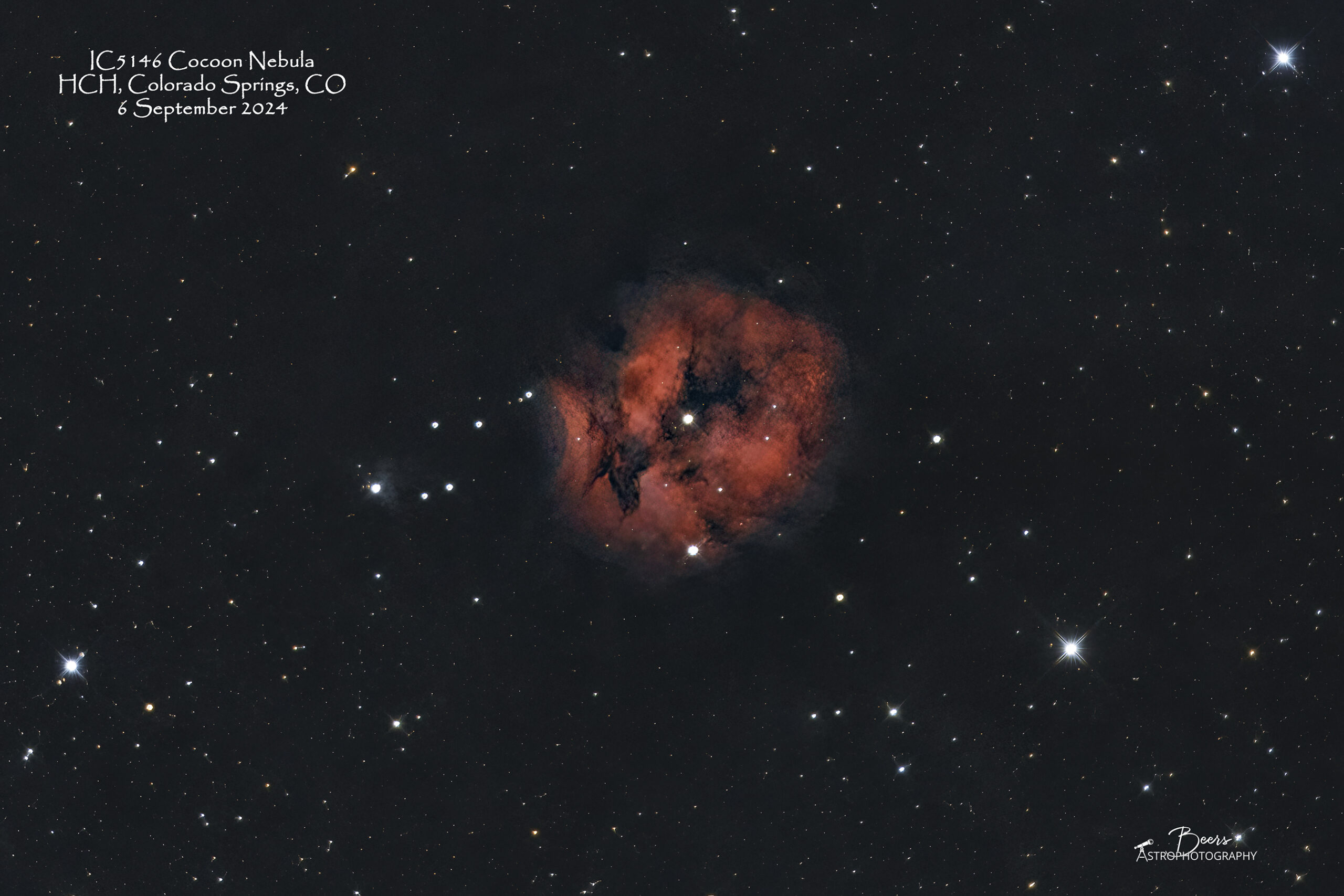
So to summarize this almost month’s long EAF learning campaign… I’ve focused (no pun intended) on getting the ZWO EAF to work reliably during a SGPro sequence execution. I’ve mastered both the in/out movement experiment and the step-size exercise, such that I can run them easily without fumbling. I’ve gathered sparse data across three telescopes and three filters. I will need to continue to conduct the step size exercise to fill in the missing telescope/filter configurations and then figure out a way to capture this information into SGP equipment profiles (without having to make a separate profile for each telescope, filter, gain combination! Overall, time well spent to learn how to use the EAF to improve the focus quality of my images.
